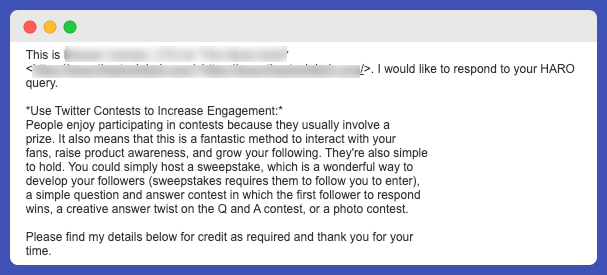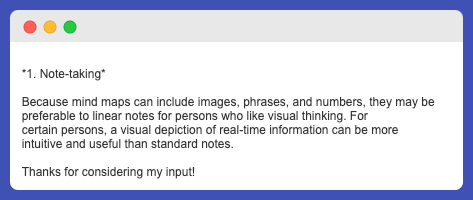The promise of free press from Help a Reporter Out (HARO) has attracted droves of PR practitioners, content marketers, and aspiring thought leaders, where sources pitch answers “Craigslist style”, hoping they’ll be cited by these publications.
In case you’re wondering, HARO is a service created by Cision that attempts to connect journalists and publications with sources. The barrier of entry is low. Sources can sign up to the database by simple registration, select which topics they are knowledgeable in, and begin receiving regular emails from HARO (which compiles all topics and queries that journalists are looking for).
The downside of this free service is that the platform has gotten saturated and it’s more and more difficult to get your pitch accepted.
At the same time, because of this democratization, it’s easier than ever to get press if you understand what publishers are looking for:
- Benefits of HARO for publishers and sources
- How queries are accepted or rejected - an example
- HARO submitting tips from publishers to pitch your insights
Ready when you are.
Benefits of HARO for publishers and sources
It’s difficult to ignore HARO when sources have the chance to be quoted by publications such as New York Times and Forbes, as well as niche blogging sites, media outlets, and business blogs of SaaS companies. Not only is this helpful with media coverage, but it’s also extremely valuable to those in SEO because of link building implications - there’s a high chance the publication will link to your website.
At ClickUp, we utilize HARO as a publisher for part of our content strategy to connect with relevant project managers and thought leaders who have something to say about workflows, productivity, and managing projects.
Every time we post a query, we receive 50-300 pitches. Because of this overwhelming number of responses, individual pitches need to work hard to stand out to our editors.
But there’s good news for the aspiring PR professional. We receive so many junk pitches that good sources and responses are coveted. In fact, these people become part of our contributor network and get the opportunity to contribute regularly.
How queries are accepted or rejected - an example
I’ve pulled back the curtain to reveal our process for vetting responses. When we push out a query, we judge responses based on the four criteria, which I’ve named the CARE framework. CARE stands for Credentials, Authenticity, Relevancy, and Exclusivity.
Credentials: Are you qualified to answer?
At the core of our requirements, we are looking for someone who’s qualified to answer. You can’t believe how often we get SEO specialists or co-founders answering a query when we’ve specifically asked for people with project management job titles to give an opinion about Gantt chart examples.
Authenticity: How real is this source?
This is a bit more subjective, but after running many queries, we’ve gotten good at trusting our intuition about a certain answer or person. Fake profiles or plagiarism are instantly reported and blacklisted.
Relevancy: Is this what we are looking for?
How relevant are the answers to the questions we posed? It often surprises us how many responses we receive that only answer one question when we’ve asked 3.
Exclusivity: Does this have a unique point of view?
Exclusivity and uniqueness go hand-in-hand. We can tell when a person has first-hand knowledge of the query and not just rehashing an answer found on Google.
With these four criteria, we get a simple scoring matrix like the one below:
| Article: Tips to Find Luke Skywalker | Leia Organa Solo | Maz Kanata | Supreme Leader Snoke | BB-8 |
| Credentials (1-5) | 5 | 4 | 3 | 2 |
| Authenticity (1-5) | 5 | 3 | 1 | 5 |
| Relevancy (1-5) | 5 | 4 | 1 | 1 |
| Exclusivity (1-5) | 5 | 4 | 3 | 3 |
| Total | 20 | 15 | 8 | 11 |
I’ve spoken to several community managers and content managers of major publications who use HARO to source contributors to their thoughts and advice on how to best get your pitch accepted. Hopefully, this will give you the best chance for your quote to be accepted!
HARO submitting tips from publishers to pitch your insights
Advice for answering a HARO query is not unlike some best practices recommended by journalists when it comes to standard email pitching. First up:
Take your time
An overwhelming number of my colleagues agreed about this. While the majority of advice-giving HARO tips suggest you submit a quote as fast as possible since journalists are looking for an answer right away, that’s simply not what we’re looking for.
In fact, suggestions like this are the reason we generally reject all answers sent to us immediately after a query goes live.
Anna Żur, Junior Marketing Specialist at Delante, has similar advice:
Don't rush into answering queries - it's better to spend more time on your submission than to rush into sending just anything. If the deadline allows it, take more time. Prepare insightful, refined, long answers that will allow publishers to understand your point of view and pick the most useful parts out of your submission. It's not a race - publishers need good quality answers rather than a super quick response.
Be relevant and complete in your answer
You wouldn’t believe how often we don’t receive relevant answers to our questions.
For example, this is a submission we received when we asked product managers to share their release management process. In this query, we asked very specific questions about their release planning process, the pace of release at their company, and any release management tools they used.

Saurabh Wani, Digital Marketing Specialist at Zoomshift has encountered similar experiences:
Relevant and on-point messages are best. Most of the answers are irrelevant and people respond to the answers just for the sake of it. I recently asked about HR tools and I got responses about email marketing and sales automation tools. Also, some answers were 300+ words that didn’t make sense.”
Pay attention to detail
Nowadays, you can easily find HARO pitching templates online. My advice is, don’t use a template as-is. Though having a template is a good starting point for getting your pitch structure in place, when content teams read the same over and over again, it’s easy to miss a good answer
There are tons of people who just use the same template over and over again, and all it takes us is a quick peek to check if they've really contributed something insightful or have done it just for the sake of the brand mentions. - Sreeram Sharma, Content Marketer @ LEAD
Oftentimes, publications will specify that they are looking for answers from people with a specific role or credential. If you don’t match these requirements closely, there’s a slim chance that we’ll accept your answer.
When we ask for project managers to submit, we frequently get pitched submissions from CEOs or founders. While there’s nothing wrong with being a CEO, your answer is immediately discounted because you did not follow directions.
Berenika Teter, SEO Specialist at Klaus recommends pitching to HARO just like you would in an email:
Answer the queries selectively, only when you actually have something to say, and try to match the query and publisher’s requirements as closely as possible. Like regular email pitches, publishers can receive hundreds of responses via HARO too, so the more effort you make to respond to the query as opposed to spamming, the higher the chances you’ll actually get a mention or whatever it is that you’re after.
Be original and insightful
The content team at most publications will already have a working knowledge of the topic they’re asking questions about, so regurgitating generic information isn’t going to be helpful to their article. Sometimes, they already have an article written and are looking to plug in a “so what” or opinion from a contributor, not rehashed “best practices” or obvious statements of fact.
For example, we asked for some unique examples of mind maps and personal thoughts on the pros and cons of using mind mapping as a planning & brainstorming tool. This was one answer that came back:

While this is a good fact about mind maps, there is nothing quotable for us to use – our in-house writers already know the fact that mind maps benefit visual thinkers. In this case, the contribution was not unique enough to make the cut, compared to other contributions we received.
Spela Mlekuz, Content Marketing Coordinator at Databox (which publishes at least 100 contributions through HARO per month), mentions that vague or generic responses are typically due to the fact that the contributor has little to no expertise in the field:
An excellent HARO submission is one that includes original data, provides some use cases to better buttress the contributor’s point, shares results or lessons learned from past experience(s), and includes unique industry examples. We make it clear that quotes go through 6 pairs of eyes and are selected based on originality, insightfulness, and not length.
Have a unique headline/subject line
Besides the fact that a great headline or subject line draws more attention and stands out amidst a sea of generic ones, this is also important for technical reasons.
Answers to HARO queries flood into our inboxes and depending on the email provider, queries with the same subject line are grouped together into one thread, making it hard for any of those answers to stand out.
In fact, the authenticity of the answers may be questioned if the subject lines are all the same. For example, we may wonder if the same person - usually a freelancer or agency– submitted answers for different companies multiple times in hopes of landing a placement.
Continue the relationship
Companies who are actively building their contributor database appreciate personal interaction and even if your quote is not accepted the first time around, opportunities can come from building good relationships.
At ClickUp, we regularly ask for contributions from previous high-quality sources, because they’ve proven that they can provide value. Thylan Le, Community Manager at Terkel, even encourages HARO users to connect on LinkedIn to continue the relationship:
Most people recommend steering clear of LinkedIn requests to publishers because it seems overwhelming and "sale-sy." However, I love relevant LinkedIn requests from HARO users! For example, I got a LinkedIn request from another Community Manager at a SaaS platform who would certainly provide value to my professional network. We had similar roles and I was happy to accept her LinkedIn request. Avoid spamming publishers who are not relevant to your industry, niche, or job title.
💡 Learn how to create effective media monitoring queries using Prowly from this article based on real-life examples.
Wrapping up
It’s easier than ever to receive free press with the rise of online platforms such as HARO (and other alternatives similar to it). If you follow the steps above and understand what content teams are looking for, you’ll be a coveted source for a publication and teams will be that much more grateful for your help.
That being said, free does come with a cost, and if you’re looking for more streamlined ways of getting press you should try PR tools like Prowly. This tool comes with a solid contact database, and recommendations for your pitch, including spam checks, smart email suggestions, and analytic tools to track your performance.
About the Author:
Mason Yu is Sr. SEO Specialist at ClickUp, all-in-one project management software, where he manages hundreds of outreach partnerships and contributes to the SEO strategy. He was a former professional violinist and co-founder of the internationally award-winning Omer Quartet, touring the nation and Europe regularly. Mason fell into digital marketing 4 years ago, freelancing for clients while concertizing and launching an online marketing course for music teachers during the pandemic.

